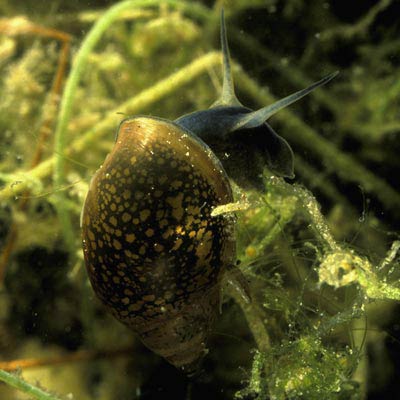Physella acuta
|
Physella acuta. (Photo: © Dr. Roy Anderson, MolluscIreland) |
|
Physella acuta. (Photo: © Dr. Roy Anderson, MolluscIreland) |
|
Physella acuta. (Photo: © N. Yotarou, Wikipedia) |
|
Physella acuta. (Photo: © F.W. Schultes, Wikipedia) |
Family
Physidae
Species
Physella acuta (Draparnaud, 1805)
Common name
European physa, Left-handed pondsnail, Acute baldder snail, Ashy physa, Lateritic physa, Pewter physa, Tadpole snail, Pewter physa
Description
The European physa has a sinistralSinistral:
Having the opening of the shell on the left side when the observer hold the shell so that the apex is upwards and the aperture faces them.
(left-handed) shellShell:
A hard, inflexible, calcareous or chitinous structure that vary in size and may either completely encasing the animal, covering some part of it or be internal.
that is 7-12 mm high and 7-10 mm wide, with 5-6 whorlsWhorls:
Pleural of whorl. A whorl is a complete spiral turn/growth of the shell of a mollusc. The whorls are counted from the apex outwards.
. This snail has a very large body whorlBody whorl:
The large, final coil (most recently formed) of a mollusc shell that contains the body of the snail, i.e. from the aperture to approximately one whorl back.
, relative to the rest of the shellShell:
A hard, inflexible, calcareous or chitinous structure that vary in size and may either completely encasing the animal, covering some part of it or be internal.
. The heightHeight:
The height of the shell is a measure of the distance between the apex and the most basal part of the shell OR the measurement taken from the apex of the shell to the base, when measured parallel to the axis of the shell.
of the body whorlBody whorl:
The large, final coil (most recently formed) of a mollusc shell that contains the body of the snail, i.e. from the aperture to approximately one whorl back.
accounts for approximately 75 % of the total heightHeight:
The height of the shell is a measure of the distance between the apex and the most basal part of the shell OR the measurement taken from the apex of the shell to the base, when measured parallel to the axis of the shell.
of the shellShell:
A hard, inflexible, calcareous or chitinous structure that vary in size and may either completely encasing the animal, covering some part of it or be internal.
. The vacant shellShell:
A hard, inflexible, calcareous or chitinous structure that vary in size and may either completely encasing the animal, covering some part of it or be internal.
has a tan color, but in living specimens the body whorlsWhorls:
Pleural of whorl. A whorl is a complete spiral turn/growth of the shell of a mollusc. The whorls are counted from the apex outwards.
appears mottled (black and tan spots and blotches). The apertureAperture:
The major opening of a shell that the body of the animal may be retracted.
(mouth) is oval and may have a white rib. The opaqueOpaque:
Not having the ability to see through an object. (Not transparent or translucent)
shell has a pointed spireSpire:
All the coils (whorls) of a shell above the body whorl.
and does not have a rigid structure blocking the opening of the shellShell:
A hard, inflexible, calcareous or chitinous structure that vary in size and may either completely encasing the animal, covering some part of it or be internal.
(operculum). The body of the animal is blue-grey in color with innumerable dark spots.
Distribution
North America:
- U.S.: Wyoming
Australasia: Australia, New Zealand
Asia: Hong Kong
Europe: Croatia, Germany, Netherlands, Czech Republic, Britain, Ireland
Other: Mediterranean region
Ecology
This species inhabits shallow, warm, standing fresh water in very high densities. It is able to withstand polluted water and is often introduced inadvertently into new habitats by humans. This species is very adaptable and is recorded as a serious pest of both economic plants in greenhouses and filtering vegetation in sewage treatment plants.
Synonyms
- Haitia acuta
- Physella heterostropha (Say, 1817)
- Physa globosa Haldeman, 1841
- Physella integra (Haldeman, 1841)
References
Albrecht et al. 2009Albrecht et al. 2009:
Albrecht, C., O. Kroll, E.M. Terrazas and T. Wilke. 2009. Invasion of ancient Lake Titicaca by the globally invasive Physa acuta (Gastropoda: Pulmonata: Hygrophila). Biol. Invasions. 11: 1821-1826.; Anderson 2003Anderson 2003:
Anderson, R. 2003. Physella (Costatella) acuta Draparnaud in Britain and Ireland- its taxonomy, origins and relationships to other introduced Physidae. Abstract of Paper from Journal of Conchology 38(1): 7.; Anderson 2005Anderson 2005:
Anderson, R. 2005. An annotated list of the non-marine Mollusca of Britain and Ireland. Journal of Conchology 38: 607-637.; Cope and Winterbourn 2004Cope and Winterbourn 2004:
Cope, N.J. and Winterbourn, M.J. 2004. Competitive interactions between two successful molluscan invaders of freshwaters: an experimental study. Aquatic Ecology. 38: 83-91.; Semenchenko et al. 2008Semenchenko et al. 2008:
Semenchenko, V., T.L. Laenko and V. Razlutskij. 2008. A new record of the North American gastropod Physella acuta (Draparnaud 1805) from the Neman River Basin, Belarus. Aquatic Invasions. 3(3): 359-360.





